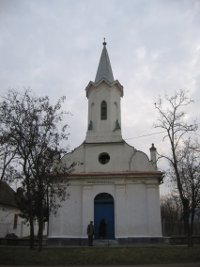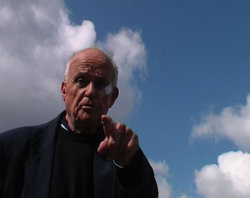Czech Republic, 2009, 23 min
Michal Pavlásek
30.01.2010 17:40
 In the middle of the 20th century a numerous group of Moravian reformed evangelicals from the surroundings of Kloubouky u Brna came to the area of Serbien Banat in Vojvodina. One-and-half-century-lasting existence of the reformed charge brought to its members much suffering borne by a process of big history stretching up to the presence. At the beginning of the 21st century the community of Czech speaking reformed evangelicals is dwelling at the verge of determination as the source of belief has been abandoned by the younger generation due to migration and impacts of modern era. The documentary focuses on historical turning points and fates of several charge members. In the foreground, inner latent godlines of the remaining descendants of the Moravian transmigrants appears which represents collective memory and symbolical universum – sources of preserved ethnicity. Faith, fate, presence as experienced past, experienced past as a garvestone.
In the middle of the 20th century a numerous group of Moravian reformed evangelicals from the surroundings of Kloubouky u Brna came to the area of Serbien Banat in Vojvodina. One-and-half-century-lasting existence of the reformed charge brought to its members much suffering borne by a process of big history stretching up to the presence. At the beginning of the 21st century the community of Czech speaking reformed evangelicals is dwelling at the verge of determination as the source of belief has been abandoned by the younger generation due to migration and impacts of modern era. The documentary focuses on historical turning points and fates of several charge members. In the foreground, inner latent godlines of the remaining descendants of the Moravian transmigrants appears which represents collective memory and symbolical universum – sources of preserved ethnicity. Faith, fate, presence as experienced past, experienced past as a garvestone.
Language of dialogues: Czech
Germany, 2006, 15 min
Martin Gruber
30.01.2010 22:05
 In the summer of 2001 the IWF in Göttingen hosted the conference »Origins of Visual Anthropology – Putting the Past Together«. Important representatives of the field came together to discuss the history of the subdiscipline. Three students were equally interested in their visions about »The Future of Visual Anthropology«. They conducted brief interviews concerning this question with filmmakers and scholars such as Jean Rouch, Ian Dunlop, Paul Henley, Karl Heider, Howard Morphy, Peter Crawford, Harald Prins and Jay Ruby.
In the summer of 2001 the IWF in Göttingen hosted the conference »Origins of Visual Anthropology – Putting the Past Together«. Important representatives of the field came together to discuss the history of the subdiscipline. Three students were equally interested in their visions about »The Future of Visual Anthropology«. They conducted brief interviews concerning this question with filmmakers and scholars such as Jean Rouch, Ian Dunlop, Paul Henley, Karl Heider, Howard Morphy, Peter Crawford, Harald Prins and Jay Ruby.
»The Future of Visual Anthrolopogy« presents the common themes that were touched upon during these conversations by juxtaposing different perspectives. The film is a reflection on how people talk and think about the future, present and past of Visual Antrhropology in 2001.
Language of dialogues: English, French
Language of subtitles: English
Portugal, 2009, 59 min
António Joao Saraiva
30.01.2010 20:45
 Fajãs, living between the seaside and the cliffs...
Fajãs, living between the seaside and the cliffs...
between the sharing and the silence...
between the music and the faith...
People taking their time..
This documentary intends to participate in the understanding of the life of people who were emigrated and returned and others who have just arrived.
Award: Grande Prémio de Festival Cinema Antropológico, Lisboa 2009
Language of dialogues: Portuguese
Language of subtitles: English
 In the middle of the 20th century a numerous group of Moravian reformed evangelicals from the surroundings of Kloubouky u Brna came to the area of Serbien Banat in Vojvodina. One-and-half-century-lasting existence of the reformed charge brought to its members much suffering borne by a process of big history stretching up to the presence. At the beginning of the 21st century the community of Czech speaking reformed evangelicals is dwelling at the verge of determination as the source of belief has been abandoned by the younger generation due to migration and impacts of modern era. The documentary focuses on historical turning points and fates of several charge members. In the foreground, inner latent godlines of the remaining descendants of the Moravian transmigrants appears which represents collective memory and symbolical universum – sources of preserved ethnicity. Faith, fate, presence as experienced past, experienced past as a garvestone.
In the middle of the 20th century a numerous group of Moravian reformed evangelicals from the surroundings of Kloubouky u Brna came to the area of Serbien Banat in Vojvodina. One-and-half-century-lasting existence of the reformed charge brought to its members much suffering borne by a process of big history stretching up to the presence. At the beginning of the 21st century the community of Czech speaking reformed evangelicals is dwelling at the verge of determination as the source of belief has been abandoned by the younger generation due to migration and impacts of modern era. The documentary focuses on historical turning points and fates of several charge members. In the foreground, inner latent godlines of the remaining descendants of the Moravian transmigrants appears which represents collective memory and symbolical universum – sources of preserved ethnicity. Faith, fate, presence as experienced past, experienced past as a garvestone.
 In the summer of 2001 the IWF in Göttingen hosted the conference »Origins of Visual Anthropology – Putting the Past Together«. Important representatives of the field came together to discuss the history of the subdiscipline. Three students were equally interested in their visions about »The Future of Visual Anthropology«. They conducted brief interviews concerning this question with filmmakers and scholars such as Jean Rouch, Ian Dunlop, Paul Henley, Karl Heider, Howard Morphy, Peter Crawford, Harald Prins and Jay Ruby.
In the summer of 2001 the IWF in Göttingen hosted the conference »Origins of Visual Anthropology – Putting the Past Together«. Important representatives of the field came together to discuss the history of the subdiscipline. Three students were equally interested in their visions about »The Future of Visual Anthropology«. They conducted brief interviews concerning this question with filmmakers and scholars such as Jean Rouch, Ian Dunlop, Paul Henley, Karl Heider, Howard Morphy, Peter Crawford, Harald Prins and Jay Ruby. Fajãs, living between the seaside and the cliffs...
Fajãs, living between the seaside and the cliffs...